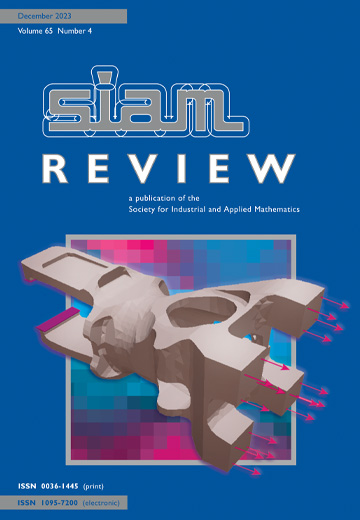混合精度的牛顿法
IF 10.8
1区 数学
Q1 MATHEMATICS, APPLIED
引用次数: 8
摘要
. 我们研究了用降精度算法来求解牛顿阶跃的线性方程。如果在线性解中忽略后向误差,那么众所周知的收敛理论表明,在线性解中使用单精度对非线性收敛率的影响很小(cid:11)。然而,如果考虑到e(cid:11)个方面的向后误差,那么通常的教科书估计是非常悲观的,甚至使用概率四舍五入分析的6个最先进的估计也不完全符合实验。我们用一个特殊(cid:12)c的例子报告实验7。我们用双精度、单精度和半精度存储和分解雅可比矩阵。在单精度情况下,我们观察到非线性迭代的收敛率不会随着维数的增加而降低,并且非线性迭代统计基本上与双精度计算相同。在半精度下,我们看到非线性收敛率虽然很差,但不会随着维度的增加而降低。11的观众。本文的目的是为学生谁已经完成或正在采取的入门级研究生课程12数值分析和教师谁教数值分析。本文的主要思想是0符号、(cid:13)定位13点精度、线性解算的后向误差和牛顿法。本文章由计算机程序翻译,如有差异,请以英文原文为准。
Newton's Method in Mixed Precision
. We investigate the use of reduced precision arithmetic to solve the linear equation for the Newton step. If one 3 neglects the backward error in the linear solve, then well-known convergence theory implies that using single precision in the 4 linear solve has very little negative e(cid:11)ect on the nonlinear convergence rate. 5 However, if one considers the e(cid:11)ects of backward error, then the usual textbook estimates are very pessimistic and even the 6 state-of-the-art estimates using probabilistic rounding analysis do not fully conform to experiments. We report on experiments 7 with a speci(cid:12)c example. We store and factor Jacobians in double, single, and half precision. In the single precision case we 8 observe that the convergence rates for the nonlinear iteration do not degrade as the dimension increases and that the nonlinear 9 iteration statistics are essentially identical to the double precision computation. In half precision we see that the nonlinear 10 convergence rates, while poor, do not degrade as the dimension increases. 11 Audience. This paper is intended for students who have completed or are taking an entry-level graduate course in 12 numerical analysis and for faculty who teach numerical analysis. The important ideas in the paper are O notation, (cid:13)oating 13 point precision, backward error in linear solvers, and Newton’s method.
求助全文
通过发布文献求助,成功后即可免费获取论文全文。
去求助
来源期刊

SIAM Review
数学-应用数学
CiteScore
16.90
自引率
0.00%
发文量
50
期刊介绍:
Survey and Review feature papers that provide an integrative and current viewpoint on important topics in applied or computational mathematics and scientific computing. These papers aim to offer a comprehensive perspective on the subject matter.
Research Spotlights publish concise research papers in applied and computational mathematics that are of interest to a wide range of readers in SIAM Review. The papers in this section present innovative ideas that are clearly explained and motivated. They stand out from regular publications in specific SIAM journals due to their accessibility and potential for widespread and long-lasting influence.
 求助内容:
求助内容: 应助结果提醒方式:
应助结果提醒方式:


